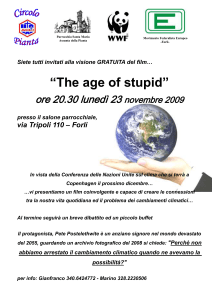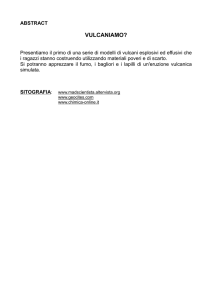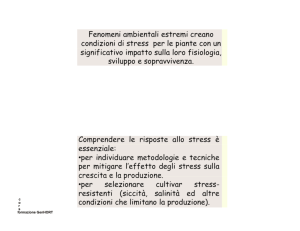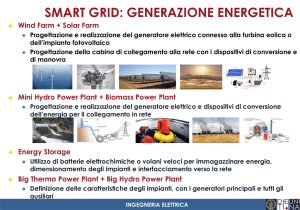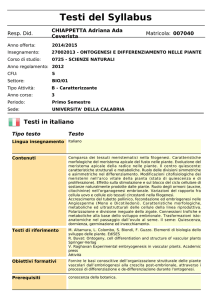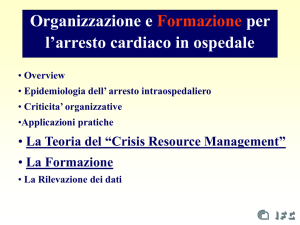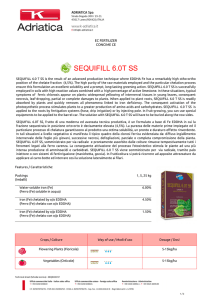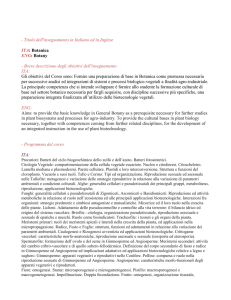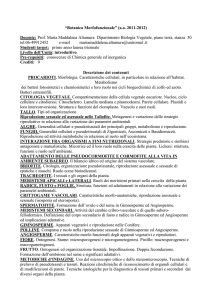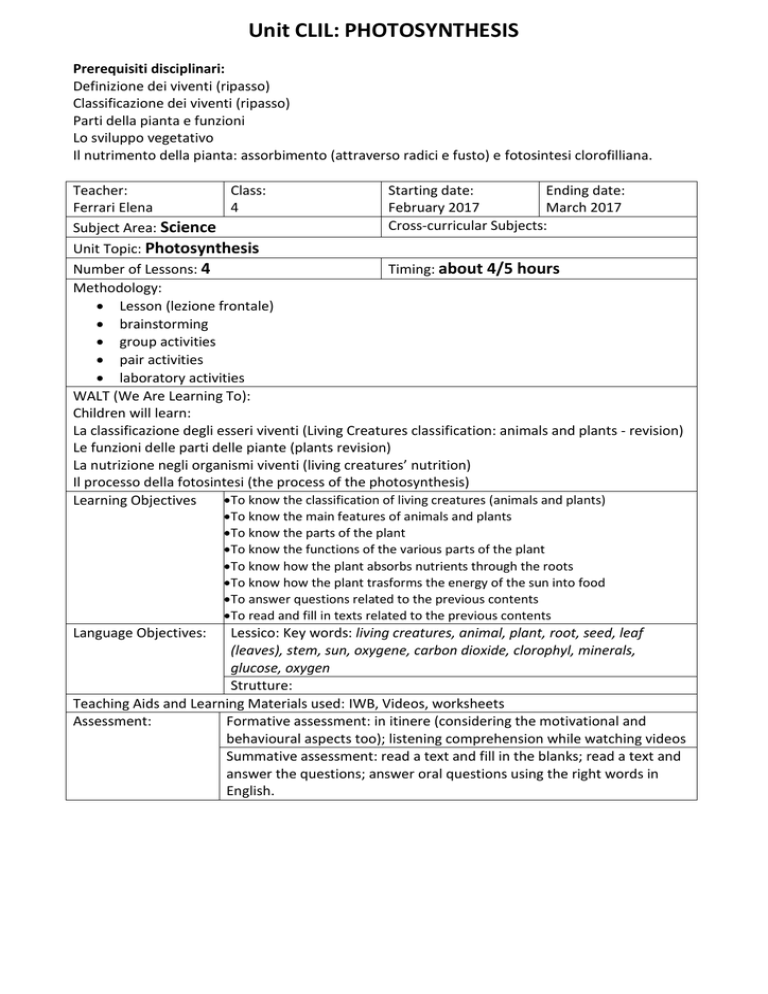
Unit CLIL: PHOTOSYNTHESIS
Prerequisiti disciplinari:
Definizione dei viventi (ripasso)
Classificazione dei viventi (ripasso)
Parti della pianta e funzioni
Lo sviluppo vegetativo
Il nutrimento della pianta: assorbimento (attraverso radici e fusto) e fotosintesi clorofilliana.
Teacher:
Class:
Starting date:
Ending date:
Ferrari Elena
4
February 2017
March 2017
Cross-curricular Subjects:
Subject Area: Science
Unit Topic: Photosynthesis
Number of Lessons: 4
Timing: about 4/5 hours
Methodology:
Lesson (lezione frontale)
brainstorming
group activities
pair activities
laboratory activities
WALT (We Are Learning To):
Children will learn:
La classificazione degli esseri viventi (Living Creatures classification: animals and plants - revision)
Le funzioni delle parti delle piante (plants revision)
La nutrizione negli organismi viventi (living creatures’ nutrition)
Il processo della fotosintesi (the process of the photosynthesis)
To know the classification of living creatures (animals and plants)
Learning Objectives
To know the main features of animals and plants
To know the parts of the plant
To know the functions of the various parts of the plant
To know how the plant absorbs nutrients through the roots
To know how the plant trasforms the energy of the sun into food
To answer questions related to the previous contents
To read and fill in texts related to the previous contents
Language Objectives:
Lessico: Key words: living creatures, animal, plant, root, seed, leaf
(leaves), stem, sun, oxygene, carbon dioxide, clorophyl, minerals,
glucose, oxygen
Strutture:
Teaching Aids and Learning Materials used: IWB, Videos, worksheets
Assessment:
Formative assessment: in itinere (considering the motivational and
behavioural aspects too); listening comprehension while watching videos
Summative assessment: read a text and fill in the blanks; read a text and
answer the questions; answer oral questions using the right words in
English.
LESSON 1 Living Creatures classification: animals and plants
Plants: parts and functions
Learning
Objectives
Timi
ng
Teaching Procedure -Activities
Lexis and
Structures
Teaching Aids
and materials
20
min
Starter:
Brainstorming:
scriviamo al centro della LIM LIVING
CREATURES
Utilizzando il metodo del code
switching, se i bambini dicono le parole
collegate agli organismi viventi in
italiano, l’ins. le traduce in inglese e le
trascrive, posizionandole in due gruppi,
a seconda che si riferiscano al regno
animale o a quello vegetale. Saranno gli
alunni stessi a ricordare poi la
classificazione già imparata tra piante e
animali.
La mappa creata dal brainstorming sarà
salvata nella LIM o riproposta in forma
di cartellone.
living creatures
animals and plants
Differences between
animals and plants
…
IWB
To know the
parts of the
plant
20
min
Presentiamo un video in lingua inglese
dove vengono visualizzate le parti della
pianta (alcune già conosciute dagli
alunni).
Proponiamo quindi una scheda con le
parti della pianta, su cui mettere le
etichette utilizzando le parole emerse
dal brainstorming.
In alternativa si potrà dare il tempo agli
alunni di disegnare la sagoma di un
albero, aiutandoli con un esempio alla
LIM.
To know the
functions of the
parts
20
min
Presentiamo un video in lingua inglese
dove vengono visualizzate le funzioni
delle varie parti sopra menzionate (qui
selezionati due, tra cui scegliere, o si
possono presentare entrambi).
Si dà il tempo anche per completare la
nomenclatura nella scheda assegnata o
nel disegno proposto.
To know the
classification of
living creatures
(animals and
plants)
To know the
main features of
animals and
plants
root, seed, leaf
(leaves), stem,
branch, flower,
fruit
It takes energy …
It anchors ….
It absorbs …
It attracts …
It carries ….
It produces ….
IWB
Video on line
IWB
Video on line
LESSON 2: The plants Nutrition
The process of Photosynthesis
Learning
Objectives
Timi
ng
Teaching Procedure -Activities
Lexis and Structures
Teaching Aids
and materials
To know the
functions of the
various parts of
the plant
10
min
Starter:
Ripasso dei concetti fondamentali
introdotti durante la lezione
precedente, anche con la visione di
uno dei video già presentati.
root, seed, leaf (leaves), IWB
stem, trunk, branch,
flower, fruit
To know how
the plant
absorbs
nutrients
through the
roots
To know how
the plant
trasforms the
energy of the
sun into food
30
min
Presentiamo un video in lingua
inglese dove viene spiegato il
processo nutritivo delle piante.
Presentiamo una scheda in cui
viene proposto un esperimento
che mette in evidenza l’importanza
della luce solare nella crescita delle
piante
Presentiamo una scheda in cui
viene riassunto in maniera
schematica e con le parole chiave il
processo della fotosintesi.
Clorophyl, sunlight,
oxygen, glucose, carbon
dioxide, energy,
It traps …
It transforms …
It produces …
It absorbs …
Video on line
LESSON 3: The process of Photosynthesis
Learning
Objectives
To know the
process of
photosynthesis
Timi
ng
Teaching Procedure -Activities
Lexis and Structures
Teaching Aids
and materials
10
min
Starter:
Ripasso dei concetti fondamentali
introdotti durante la lezione
precedente.
See previous lessons
IWB
30
To know the
min
process of
photosynthesis
To use the
information
and to
rearrange it to
complete a text
or to answer the
questions
Presentiamo un video con le
informazioni principali del processo
della fotosintesi in lingua inglese.
In seguito leggiamo una pagina
sull’argomento selezionata in un
sito scientifico, che presenta anche
un semplice video esplicativo.
Presentiamo ora una scheda
riassuntiva con alcune parti da
completare, riutilizzando il lessico
già introdotto.
Video on line
Worksheet


